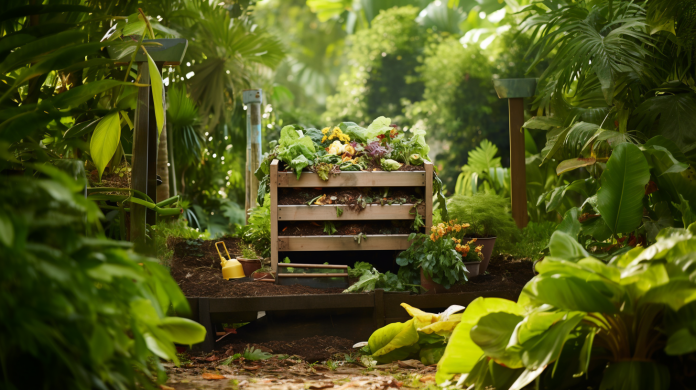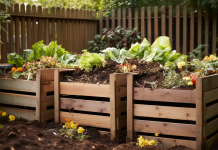Welcome to our article on the science behind composting, where we delve into the transformation of organic matter into the coveted ‘black gold.'
Through the breakdown process, microorganisms play a crucial role in composting, while maintaining the ideal temperature and moisture levels is essential for success.
Additionally, achieving the right carbon to nitrogen ratio and employing various composting methods contribute to the creation of nutrient-rich compost that enhances plant growth and soil health.
Join us as we explore the fascinating world of composting and its numerous benefits.
The Decomposition Process: Breaking Down Organic Matter
Composting involves several stages of decomposition, each playing a vital role in breaking down the organic material.
The first stage, known as the mesophilic stage, occurs at temperatures between 20 to 45 degrees Celsius. During this stage, bacteria, fungi, and other microorganisms begin to break down the organic matter, producing heat as a byproduct.
The next stage is the thermophilic stage, where the temperature rises to around 50 to 65 degrees Celsius. Here, thermophilic bacteria take over, accelerating the decomposition process.
The final stage is the maturation stage, where the temperature decreases, and the decomposition slows down. Throughout these stages, oxygen plays a critical role in facilitating the breakdown of organic matter, ensuring the efficient conversion into nutrient-rich compost.
Microorganisms: The Heroes of Composting
Playing a crucial role in the composting process, microorganisms break down organic matter into nutrient-rich compost. These tiny organisms, including bacteria, fungi, and actinomycetes, feed on the organic material and break it down through their metabolic activities. The table below illustrates the different types of microorganisms involved in composting and their contributions to the process:
| Microorganism | Activity | Contribution |
|---|---|---|
| Bacteria | Aerobic and anaerobic decomposition | Breaks down simple sugars and proteins |
| Fungi | Aerobic decomposition | Breaks down complex materials like lignin and cellulose |
| Actinomycetes | Aerobic decomposition | Breaks down tough and resistant organic matter |
Temperature and Moisture: Creating the Ideal Composting Environment
Maintaining optimal temperature and moisture levels is essential for creating the ideal composting environment.
Composting is a biological process that relies on the activity of microorganisms to break down organic matter into nutrient-rich compost.
The ideal temperature for composting ranges between 110 to 160 degrees Fahrenheit (43 to 71 degrees Celsius). This temperature range promotes the growth and activity of thermophilic bacteria, which are responsible for the rapid decomposition of organic materials.
Moisture levels are equally crucial, as composting organisms require water to survive and carry out their metabolic processes. The ideal moisture range for composting is between 40 to 60 percent. This ensures that there is enough moisture for the microorganisms to thrive, but not too much water that it becomes waterlogged.
Carbon to Nitrogen Ratio: Balancing the Ingredients for Successful Composting
Achieving a balanced carbon to nitrogen ratio is crucial part of the science behind composting as it determines the rate at which organic materials break down and the quality of the resulting compost. The carbon to nitrogen ratio refers to the proportion of carbon-rich materials, such as leaves and straw, to nitrogen-rich materials, such as food scraps and grass clippings, in the composting ingredients.
Here are two important points to consider:
- The ideal carbon to nitrogen ratio for composting is generally around 30:1. This means that for every 30 parts of carbon, there should be 1 part of nitrogen. This balance ensures that the microorganisms responsible for decomposition have enough carbon for energy and nitrogen for protein synthesis.
- A carbon to nitrogen ratio that is too high (excessive carbon) can slow down the decomposition process, while a ratio that is too low (excessive nitrogen) can lead to a smelly and slimy compost pile. It is important to adjust the ratio by adding more carbon-rich or nitrogen-rich materials as needed.
Composting Methods: From Piles to Bins and Tumblers
There are several methods for composting organic matter, including using piles, bins, and tumblers. These methods can be categorized into two main types: aerobic and anaerobic composting.
Aerobic composting involves the use of oxygen to break down organic matter, which results in faster decomposition and the production of compost with a higher nutrient content. This method is commonly used in traditional composting, where organic materials are piled up and turned regularly to provide oxygen to the microorganisms responsible for decomposition.
On the other hand, anaerobic composting occurs in the absence of oxygen and is slower than aerobic composting. One popular form of anaerobic composting is vermicomposting, which involves the use of earthworms to break down organic matter. Vermicomposting has gained popularity due to its efficiency and ability to produce high-quality compost.
Both aerobic and anaerobic composting methods have their advantages and can be tailored to suit different composting needs.
Compost Benefits: Nourishing Plants and Improving Soil Health
Compost benefits both plants and soil health by providing essential nutrients and improving soil structure. The process of composting organic matter creates a nutrient-rich substance that can significantly improve crop yield and reduce waste. Here are some key benefits of using compost in gardening and agriculture:
- Nourishes plants: Compost releases essential nutrients such as nitrogen, phosphorus, and potassium, which are vital for plant growth and development. These nutrients are slowly released into the soil, providing a steady supply to the plants, resulting in healthier and more productive crops.
- Improves soil health: Compost enhances soil structure by improving its ability to retain moisture, allowing for better water infiltration and reducing the risk of erosion. It also promotes beneficial microbial activity in the soil, supporting the growth of beneficial bacteria and fungi that help break down organic matter and make nutrients more available to plants.
Key Takeaways
- Composting involves stages of decomposition, including the mesophilic stage, thermophilic stage, and maturation stage, with each stage playing a vital role in breaking down organic material.
- Microorganisms such as bacteria, fungi, and actinomycetes are essential for the breakdown of organic matter into compost through their metabolic activities.
- Maintaining optimal temperature and moisture levels, ranging between 110 to 160 degrees Fahrenheit (43 to 71 degrees Celsius) and 40 to 60 percent moisture, respectively, is crucial for creating the ideal composting environment.
- Achieving a balanced carbon to nitrogen ratio, generally around 30:1, is crucial for successful composting, as it provides enough carbon for energy and nitrogen for protein synthesis for microorganisms.
Conclusion
In conclusion, composting is a natural process that involves the decomposition of organic matter by microorganisms. The temperature and moisture levels, as well as the carbon to nitrogen ratio, play crucial roles in creating the ideal composting environment.
Various methods, such as piles, bins, and tumblers, can be used to facilitate the composting process. Ultimately, composting provides numerous benefits, including nourishing plants and improving soil health.
Please see our supporting article:
Composting 101: A Beginner’s Guide



